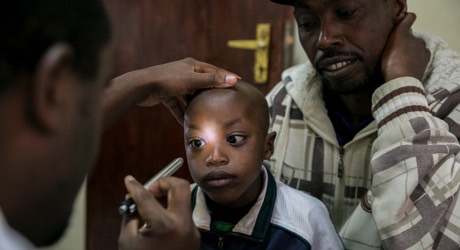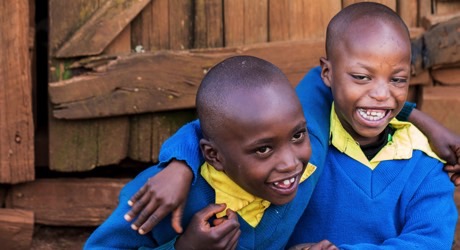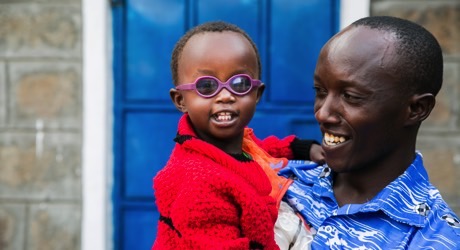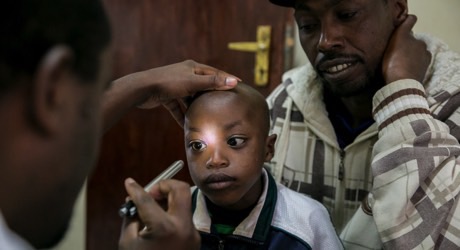Project background
Kenya is one of the largest countries in Africa. Factors such as poor education, low life expectancy and minimum wages have contributed to the high rate of unemployment, poverty and the lack of basic healthcare.
In Kenya, an estimated 945,000 people are blind or visually impaired. Cataract is the leading cause of avoidable blindness. Right now, there is a critical backlog of 100,000 people waiting for sight-restoring surgery.
Trachoma, a painful infection caused by poverty and poor sanitation, ranks second. It is considered a serious public health concern in the country.
Kenya’s rural population face many barriers to good eye health, including lack of access to health care. Almost three-quarters of all Kenyan people live in remote and regional areas with very poor access to eye health services, yet the majority of eye health professionals are concentrated in major cities.
A lack of awareness about eye health is also a major challenge. Many Kenyan people in remote and regional areas use traditional medicine and healers, rather than seeking treatment from a trained medical professional. Furthermore, poverty is critically linked to blindness. Malnutrition, inadequate health and education services, poor water and a lack of sanitation can contribute to eye disease.
Project activities
The Foundation’s focus is on delivering improvements in eye health services in rural areas where most people live and where access to health services is extremely limited.
The Foundation holds outreach and community eye screening camps, supports surgeries and treatments for cataract, trachoma and other eye disease. We partner with local training institutions to increase the number of eye health workers and surgeons in the country. We support infrastructure development and provide vital equipment.
Project results
The Foundation’s sight-restoring work in Kenya is showing excellent progress.
With your support, The Fred Hollows Foundation achieved the following results between January and March 2019:
- 104,566 people screened for eye disease
- 2,947 surgeries and treatments performed
- 839,656 people treated with antibiotics for trachoma
- 24 basic health workers trained in eye health
- 161,527 community members and children participating in school education sessions
Case study: Samuel's story

For children like Samuel, cataract can have devastating consequences. In a few short years, nine-year-old Samuel’s vision had completely deteriorated. With cataract in both eyes, he was on the path to becoming permanently blind.
Samuel is a twin, and his brother John has never left his side. Their father, Kimani, describes the brothers' special bond: “I can’t always be there for Samuel, but when they’re at school, John is. He takes his brother’s book and writes properly, because he knows his brother cannot see." Kimani winces as he recalls his son's struggle to keep up with the other children, often tripping and falling while running around in the yard. The deep scar on his cheek is a permanent reminder of how serious injuries can be for a child with blindness.
In Kenya alone, an estimated 945,000 people are blind or visually impaired. Of these, 8,000 children like Samuel have avoidable blindness.

So much of a child’s physical and intellectual development depends on their ability to see. They learn through reading and observing, and develop strength and coordination through play.
If blindness is left untreated for too long, a child’s brain can lose the ability to process visual signals, leaving them permanently blind. The sooner we can get to these children, the better the outcome. In remote villages in Kenya, like the one where Samuel lives, accessing eye health care and treatment is particularly difficult. Distance and the costs of travel simply make it impossible for many families.
Thankfully, Samuel was able to receive life-changing eye surgery through The Foundation’s partner, Sabatia Eye Hospital. The delicate operation was performed by Dr Jean Claude, one of just 8 paediatric ophthalmologists in the country trained to perform surgery on children. Samuel’s mother was delighted when she found out her son could see again, saying “I am so happy I cannot even explain it. I never thought he would ever see.”

Since the surgery, Samuel has changed so much. His mother proudly exclaimed “He’s telling his brother that he’ll perform even better than him. I would love for him to become a doctor to help others with the same problem that he had.”
What next?
The Foundation will continue to scale up its sight-restoring work in Kenya in 2019.
Project visits
Interested donors should contact The Fred Hollows Foundation.
Project Background
Kenya is a country rich in wildlife, culture, history and friendly, welcoming people. It’s a place of varied and diverse cultures, where modern meets traditional and merges into something truly unique.
Over the years, Kenya has worked hard to improve the health of its people. However, the delivery of eye health services remains a major challenge, especially in rural areas.
Poverty, lack of education about eye health and a chronic shortage of eye medical specialists all contribute to high rates of avoidable blindness.
Cataract is the leading cause of avoidable blindness. There is a critical backlog of 100,000 people waiting for sight-restoring surgery. Trachoma ranks second – an eye infection related to poverty that mostly affects people in areas that have limited access to water and sanitation.

Access to healthcare remains a key challenge. There is an acute shortage of surgeons and eye care support staff in Kenya. For every person who receives cataract surgery, there are 10 others who cannot.
Almost three-quarters of all Kenyan people live in remote and regional areas with very poor access to eye health services, yet the majority of eye health professionals are concentrated in major cities. The cost of travel, and time spent away from employment and home duties prevent many people from seeking treatment.
Project Overview
Right now, as many as 100,000 people are waiting for sight restoring surgery in Kenya. As part of this project, The Fred Hollows Foundation will work across 4 counties with large rural populations and limited access to eye health services.
We are committed to training more surgeons and clinic support staff to keep up with the growing demand for cataract surgery. Specifically, Kenya requires additional ophthalmologists and mid-level surgeons to clear the backlog of people needing surgery.

Our community and school screening camps ensure that many more people, particularly children, living in rural and remote areas are identified and treated in time.
Furthermore, we will also train 375 community health workers and 4 local eye surgeons and clinic support staff. We will screen more than 79,520 people, and perform more than 10,354 surgeries to restore sight. Lastly, we will educate more than 1.1 million community members and school children in eye health.
What's Covered in Project Costs
The $20,000 donated from The Footprints Network will allow The Fred Hollows Foundation to achieve the following outputs as part of the broader project in 2019:
- Perform as many as 277 cataract surgeries to restore sight
- Train one cataract surgeon
- Screen 500 children at an outreach school screening camp

Partners and Community Involvement
The Fred Hollows Foundation works in partnership with like-minded organisations and health providers to ensure the largest possible reach and impact of our sight restoring work.
In Kenya, we work with the Ministry of Health to support the delivery of equitable and sustained improvements across eye health services. Our focus is on the rural areas where 80% of the population live, and where access to health services is extremely limited.
The Foundation works closely with Sabatia Eye Hospital, a not for profit eye hospital in Vihiga County, and other training institutions, including the University of Nairobi.
Part of a Larger Strategy
The Foundation uses a ‘Health Systems Strengthening’ approach to ensure the delivery of comprehensive eye health for the Kenyan people. Our aim is to ensure eye health is integrated into the national and county health systems.